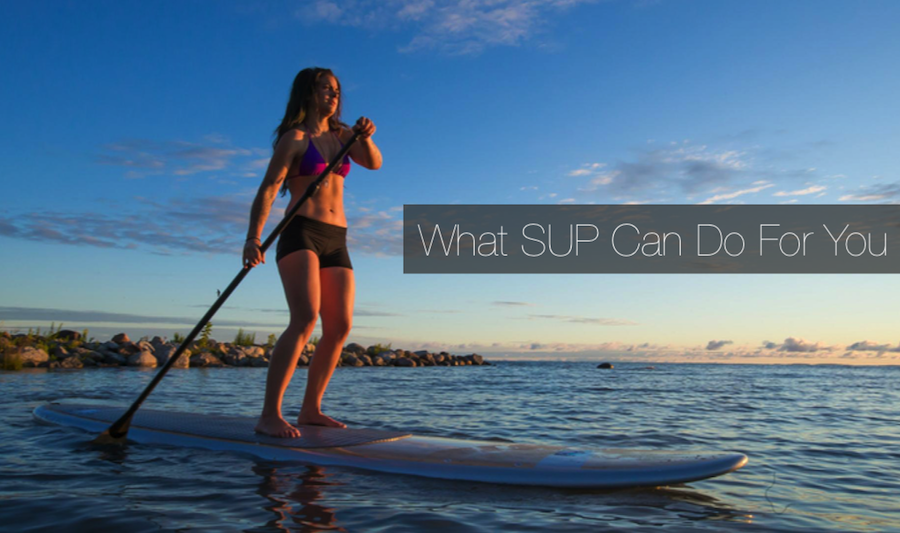
Earlier in the season, we released an article on five summertime activities that will complement your physiotherapy regime, naming hiking, kayaking, surfing, beach running and stand-up paddle boarding within. The latter was the only activity without its own dedicated article, something we’re rectifying right here today as we reach the mid-point of the summer.
Stand-up paddle boarding (or SUP from here on in) has quickly gained in popularity over the past couple of years in Burnaby and Greater Vancouver alike. And while some high impact seasonal activities end up sending us new patients, this one can be used to actually prevent and treat common injuries, while providing you with one of the healthiest forms of outdoor exercise around.
4 Ways Stand Up Paddle Boarding (SUP) Can Improve Your Physical Health and Complement Your Physiotherapy
1. Improves Balance and Core Strength
Some people come to our clinic with the explicit goal of improving balance. Whatever their motivations may be (for sport or other) it’s a worthy goal, given that improving balance can keep you free from numerous acute injuries, including those sustained from falls which is a leading cause of injury in Canadians. Given that SUPing requires you to stand upright with your feet pointed forwards towards the front center of the board, it develops both core stability and leg strength. There will be some trial and error. On your first few sessions you may spend more time in (versus on) the water than you planned, but this will lessen overtime until eventually you’ll be able to paddle while sipping on a latte.
You’ll find that with this newfound sense of balance and core strength typical day to day physical activities and sports alike will get a whole lot easier.
2. Full Body Workout
More than your legs and core are being tasked when you paddle, as your shoulder and back muscles play important roles. That’s a given you’ll note after one look and especially after your very first session. But even more important, is that SUPing will work the smaller muscles and ligaments that are typically ignored in the gym. The act of standing on the unstable platform engages the all important stabilizer muscles in the same manner that running on the beach barefoot over sand can do. When you engage your stabilizer muscles on a regular basis, you strengthen them significantly, reducing the risk of injury to the numerous body muscles, joints, and ligaments that depend upon stabilizer muscles to hold everything in place while your body is moving throughout the rest of the day.
The result is not just a reduced potential for injury, but an increase in overall strength and performance for all else that you do.
3. Cardiovascular Strength and Endurance
The average person burns anywhere between 300 and 450 calories per hour while on the water. So in addition to the musculoskeletal benefits, there are some clear cardiovascular ones that contribute to calorie burning and overall health and wellness. Studies show a notable improvement in aerobic and anaerobic fitness, in addition to multidirectional trunk endurance.
4. Can Be Used to Rehabilitate Injuries
We were tempted to include stand up paddle boards in our list of physiotherapy equipment that you can use outside of the clinic environment. That’s because SUP is a terrific means to rehab an injury in the outdoors, assuming you’re using proper form, addressed below:
- Position your feet parallel to one another, placed approximately hip-width distance apart, and centered between the edges of the stand up paddle board.
- Point your toes forward and bend your knees slightly while keeping your back straight.
- Keep your head and shoulders upright and steady, shifting your weight (as needed) by moving your hips. Maintain your gaze on the horizon and resist the urge to look down at your feet. The latter will come in time as you gain confidence.
- When you paddle on the left side of the board, your right hand should be placed on the top of the t-grip (common to all SUP paddles) with your left hand about three or four feet down its shaft. Switch sides (and hand positions) after about four strokes. Rotating sides not only prevents you from going in a circle, it balances your musculoskeletal system.
In using proper form, you are enjoying a low impact physical activity that is easy enough on your muscles and joints that it can be used as a tool for gradually increasing strength to injured areas without putting you at risk of aggravation. All of this is contingent upon paddling on days with little to no wind and current, so stick to calm days on lakes and marinas when using the SUP concept to complement your rehabilitation regime, and only do so with the approval of your physiotherapist.
Before you grab your paddle and 12 foot+ board and head for the nearest waterway we encourage you to schedule a consultation with our clinic to make sure your body is prepped to optimize the experience. Contact Absolute PhysioCare today.
